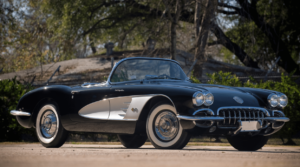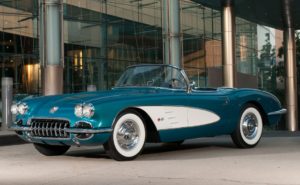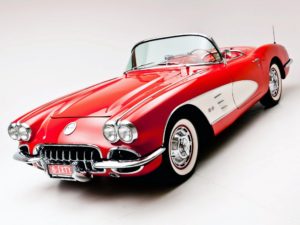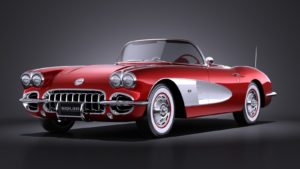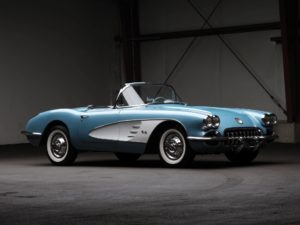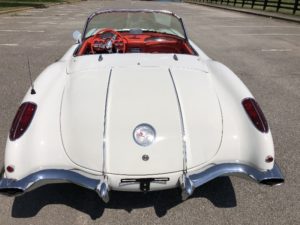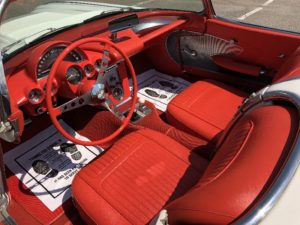To mark the fourth birthday of the Corvette, its proud parents, the Chevrolet Motor Division, announced the 1958 model which underwent some extensive but not too important changes on the surface and a few rather interesting ones underneath
Pricing: $3591.00
Engine options: 283 ci. V-8 (fuel injected or carbureted) – multiple-horsepower options available
Transmission: 3-speed manual (standard), 4-speed manual (optional), 2-speed Powerglide (optional)
Top speed: 112 mph
Units produced: 9,168
Available colors: Charcoal, Silver Blue, Panama Yellow, Tuxedo Black, Snowcrest White, Regal Turquoise, Signet Red, Inca Silver
Highlights of the year:
Drawing on inspiration from both Earl’s ‘56 Corvette and the Mercedes-Benz, a new concept car emerged that was featured at the 1956 Motorama that nearly became the basis for an all-new Corvette. This car would go on to become known as the “Oldsmobile Golden Rocket”. His “Golden Rocket” was a unit-body, two-seat coupe that sported futuristic styling that included a slim vertical grille and a protruding snout with quad headlamps – a style that was immensely popular amongst designers in Detroit.
The Oldsmobile’s front fenders swept back the length of the body to a torpedo-like rear end that was topped by small fins.
Gullwing-like sections were cut into the roof assembly to allow greater ease when entering/exiting the car. Much like the rest of the car, the roofline also tapered back in a “boattail” fashion, with a large rear window that wrapped down and around the roof. In all, the “Oldsmobile Golden Rocket” would become commonly recognized as the inspiration for Bill Mitchell’s Corvette Stingray seven years later.
As early as 1946, General Motors executives had come to a consensus that unit-body construction would be the path forward for cheaper unit cost and higher volume, both of which were items that Corvette needed to begin turning a profit. Using the Oldsmobile concept car as a model, engineers began laying out a new Corvette based on the Golden Rocket’s styling.
Early models made of clay and fiberglass showed how unit-body construction might help pave the way for a whole new era of Corvettes. Smaller and lighter than the current C1, it also compensated for many of the current design constraints that current Corvette engineers were forced to deal with.
However, this first pass at a new Corvette design never completely got off the ground. The project, which carried the name Q-Corvette, ended up getting shelved as members of the Concept Corvette development team were pulled away to other projects that demanded the attention of those who could best help in the ever-increasing sales race against Ford.
Early models made of clay and fiberglass showed how unit-body construction might help pave the way for a whole new era of Corvettes. Smaller and lighter than the current C1, it also compensated for many of the current design constraints that current Corvette engineers were forced to deal with.
However, this first pass at a new Corvette design never completely got off the ground. The project, which carried the name Q-Corvette, ended up getting shelved as members of the Concept Corvette development team were pulled away to other projects that demanded the attention of those who could best help in the ever-increasing sales race against Ford.
Other changes were made to the interior as well. The interior door panels were remodeled to include reflectors that had been added at arm level for nighttime safety. Upholstery now featured a new “pebble grain” fabric. Even seatbelts, which had been practically unheard of before that model, were standard issue – factory installed in the 1958 Corvette.
Despite some of the extreme changes to its body styling, the 1958 Corvette was the first vintage of Corvette to turn a profit for General Motors. In all, Chevrolet sold 9,168 Corvettes in the 1958 model year, which was doubly impressive when considering that the Corvette sales were up (47% over the 1957 Corvette and a staggering 150% over the 1956 Corvette) despite a year in which a financial recession had wrought havoc on the competition, leaving few manufacturers to actually turn a profit that year.
In fact, save for Ford’s new four-seat 1958 Thunderbird (and very few others), Corvette alone proved successful in the domestic automotive market.
Photos of the 1958 Corvette:
Sources:
https://www.corvsport.com/1958-c1-corvette/
https://www.caranddriver.com/reviews/a15144486/1958-chevrolet-corvette-road-test/
https://fineartamerica.com/featured/1958-corvette-by-chevrolet-interior-in-a-color-photograph-34890-m-k-miller.html
